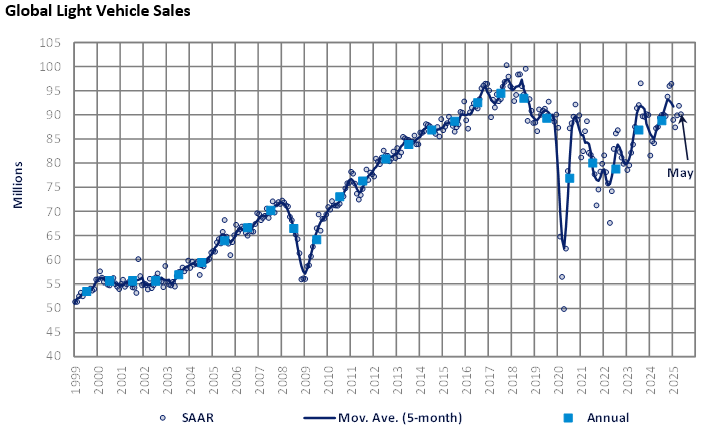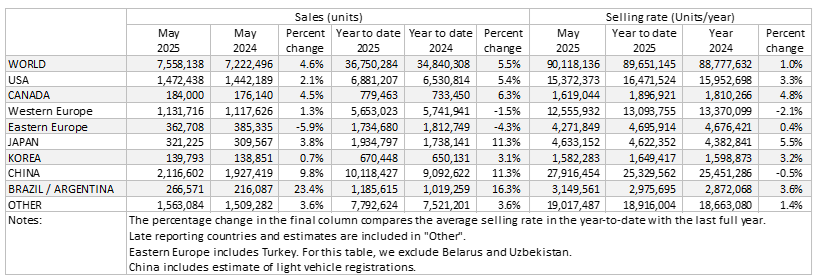For May, the Global Light Vehicle (LV) selling rate is estimated to be 90 million units/year, a slowdown from the improvement seen the previous month. In
year-on-year (YoY) terms, the market grew 5% as sales reached 7.6 million units globally.

The story remains similar to April in the key markets of China, the US, and Western Europe. China and the US saw positive growth in LV sales while sales in Western Europe continued to decline due to prevailing economic headwinds. Albeit sales in the US are beginning to slow as the industry pulls back on incentives. In other markets, sales in Japan and Korea remain robust, while in Argentina, sales experienced another month of rapid growth, up over 50% YoY.

North America
US Light Vehicle sales grew by 2.1% YoY in May, to 1.47 million units. There was one extra selling day in May 2025 as compared with May 2024, meaning that sales declined by 1.7% YoY on a selling day-adjusted basis. The annualized selling rate slowed to 15.4 million units/year in May, from 17.4 million units/year in April. The selling rate was hindered by the lack of Memorial Day sales events this year, as OEMs brace for the impact of tariffs. While price rises explicitly linked to tariffs are still rare, the industry is pulling back on incentives, which fell to US$2,609 in May, down by 2.6% YoY. This is leading to higher average transaction prices, which rose to US$46,193 in May, up by 3.1% YoY.
Canadian Light Vehicle sales totaled 184k units in May, according to initial estimates. This represents a YoY gain of 4.5%, but the selling rate slowed to 1.62 million units/year in May, from (an adjusted) 1.76 million units/year in April. Although tariffs on vehicles imported from the US are effectively quite rare due to a number of exemptions, consumers may still be pulling back from purchases as the economy slows. In Mexico, sales were estimated at 125k units in May, up by 2.3% YoY. Meanwhile, the selling rate is thought to have decelerated to 1.57 million units/year in May, from 1.61 million units/year in April. The market is still healthy overall, despite economic concerns linked to tariffs.
Europe
The LV selling rate for Western Europe slipped back slightly to 12.6 million units/year in May, though sales volume was up a modest 1% YoY. The Western European LV market has struggled to meet expectations, with it facing a drag from weak consumer confidence and broader economic uncertainty.

US Tariffs are shifting - will you react or anticipate?
Don’t let policy changes catch you off guard. Stay proactive with real-time data and expert analysis.
By GlobalDataIn Eastern Europe, the LV selling rate remained broadly flat at 4.3 million units in May. Sales were down nearly 6% YoY. The Russian LV market declined by 29% YoY in May — tight monetary policy and stalled consumer credit growth are restricting auto financing. LV sales in Turkey were up 4% YoY in May as sales reached 103k units. LV demand remains strong as here consumers continue to turn to vehicles as a safeguard against rampant inflation.
China
In May, Chinese LV sales are estimated to have grown by 10% YoY to around 2.1 mn units, broadly the same volume as April’s figure. PV sales totaled 1.9 million units, up 11.5% YoY as the selling rate reached 25.5 million units/year. YTD LV sales now stand at 10 million units, up over 11% from the same period in 2024. The PV sales performance continues to benefit from government subsidies, as the government has extended its vehicle trade-in scrappage incentive scheme through the end of 2025. Tax breaks on NEVs also continue this year.*
China’s automotive industry continues to see a vehicle price war, though this is causing financial strain, with over a third of manufacturers having liabilities exceeding assets. Major companies like BYD, Geely, and Nio have significant working capital deficits. The government is urging stabilization of supply chains and reduced discounting. Analysts expect industry consolidation by 2026 as weaker firms may fail. Profitability concerns are set to continue for now despite state support, though as state support weakens next year, GlobalData forecasts that so too will the vehicle market.
In Japan, sales increased YoY by 3.8% in May 2025, down from the prior four months of double-digit growth due to the low-base comparison to the sales a year ago (when vehicle testing irregularities issues hit vehicle production, especially at Daihatsu). The base-year effect momentum is now slowing as vehicle production mostly returned to normal. Meanwhile, OEMs are now clearing backlogged orders by increasing vehicle supply, which will continue supporting domestic vehicle market.
Korean LV sales moderated to 1% YoY in May 2025, a shift in momentum from April where sales expanded 7% YoY. The May growth data showed mixed signals, with sales of local models (-2% YoY) showing signs of softness while sales of import cars (+13% YoY) continued to point towards solid growth. The robust sales of import cars in May 2025, partly driven by the low-base effect a year ago, resulted from easing supply chain pressure of major European OEMs, and the soaring delivery of Tesla (+58% YoY).
South America
Brazilian Light Vehicle sales reached 214k units in May according to preliminary estimates, up by 17.0% YoY. The selling rate increased to 2.55 million units/year in May, from 2.47 million units/year in April. This was the strongest selling rate of the year to date, although it could have been influenced by customers returning after disruptions in the preceding months from Carnival and Easter. Hybrid and electric vehicles accounted for around 10.4% of total sales in May, a record high.
Argentina saw another extremely strong month of sales, as the recent tax reduction on many vehicles, along with the liberalization of the country to imported models, continued to boost the market. Sales totaled 52k units in May, up by 58.9% YoY, while the selling rate eased to 597k units/year in May, from an exceptionally high (upwardly adjusted) 675k units/year in April – which had been the strongest rate since August 2018.

This article was first published on GlobalData’s dedicated research platform, the Automotive Intelligence Center.





